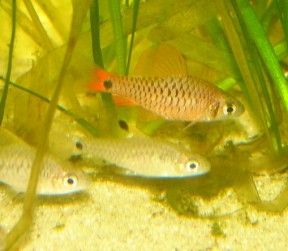Oreichthys sp. 'Myanmar Redfin'
Classification
Order: Cypriniformes Family: Cyprinidae
Distribution
Unconfirmed but apparently native to parts of the Irrawaddy River basin in northern Myanmar. There’s a strong possibility it’s been collected from a stream called Hpa Lap which is located near the village of Yuzana Myaing, off the road between Myitkyina and Myitzon which is also the type locality for Danio kyathit.
Habitat
As with other Oreichthys it’s likely to display a preference for slow-moving sections of tributaries, minor rivers and headwaters, with dense or overhanging marginal vegetation and relatively clear water.
Maximum Standard Length
35 – 40 mm.
Aquarium SizeTop ↑
An aquarium with base dimensions measuring at least 60 ∗ 30 cm is required.
Maintenance
Best kept in a well-decorated set-up with aquatic vegetation and woody structures. The addition of some floating plants to diffuse the light entering the aquarium also seems to be appreciated and the addition of dried leaf litter can add a natural feel. Filtration, or at least water flow, should be relatively gentle, and use a soft substrate if possible since Oreichthys species have miniscule sensory bristles on the lower jaw which are used when foraging.
Water Conditions
Temperature: 24 – 28 °C
pH: 6.5 – 7.5
Hardness: 36 – 215 ppm
Diet
Will accept dried foods of a suitable size but should not be fed these exclusively. Daily meals of small live and frozen fare such as Daphnia, Artemia and suchlike will result in the best colouration and encourage the fish to come into breeding condition. It’s noted as something of a shy, reluctant feeder (see below).
Behaviour and CompatibilityTop ↑
Unsuitable for most community aquaria as it may be intimidated or outcompeted for food by larger or more boisterous tankmates. Small, peaceful cyprinids such as Trigonostigma or Boraras species make good choices and we suspect it will also do ok with many South American characins, Otocinclus or pygmy Corydoras catfishes.
Potential additions from the Irrawaddy drainage include Dario hysginon, D. dayingensis and Lepidocephalichthys berdmorei. If specific geography is less of an issue there are many more suitable species from the country such as Danio erythromicron, D. margaritatus, M. rubescens, etc.
Although gregarious by nature it’s a shoaling rather than schooling fish which develops a distinct pecking order and rival males will exhibit some interesting sparring behaviour in captivity. It’s best maintained in a group of 8 or more but the tank must be decorated in such a way that many broken lines of sight are provided. If kept singly, in a very small group or in cramped conditions it can become withdrawn and subdominant fish may be bullied incessantly.
Sexual Dimorphism
Males grow a little larger than females, exhibit stronger colouration on the body and fins, and develop an extended, yellowish dorsal-fin which in dominant specimens is suffused with orange.
Reproduction
Unrecorded.
NotesTop ↑
This fish is one of several sometimes imported and sold as Oreichthys cosuatis or O. parvus which has led to considerable confusion. It appears to be an undescribed species and can be most easily identified by the absence of a dark marking in the dorsal-fin of adult males (vs. presence in O. cosuatis and O. parvus) and possession of a large, well-defined black blotch on the caudal peduncle ( vs. absent in O. cosuatis, smaller and less well-defined in O. parvus).
It seems certain that new species of Oreichthys will be described in the future as there exist at least three undescribed forms from Myanmar, four from India (including one said to originate in the Western Ghats mountain range, thus greatly extending the range of the genus), and possibly others from Thailand and the Mekong basin in laos.
Distinguishing some of these from one another and the described species can be tricky; one variant from the Dibru River in Tinsukia District, Assam state, India is very similar to O. cosuatis but has a less rounded dorsal-fin, for example, while other variants from Myanmar differ in fin colour or patterning such as the extent of the dark blotch at the caudal peduncle with the latter absent in some forms.
The genus is defined by the following characters: small size up to 43 mm SL; body deep, stout and strongly compressed; barbels absent; head with rows of fine pores, normally concentrated on the snout, interorbital area, cheeks, and opercle; simple dorsal and anal-fin rays soft and smooth; 17-21+2 scales in lateral series; lateral line visible; 3 simple and 8 branched dorsal-fin rays; 3 simple and 5 branched anal-fin rays; abdomen rounded anterior to pelvic-fin origgin, with a scaled keel between pelvic-fin base and anal-fin origin; pharyngeal teeth arranged in 3 rows of unequal length forming a pyramidal shape; prsenec of dark-grey, crescent-shaped marking on each scale; symphysal knob absent; gill rakers absent; no spine anterior to dorsal-fin origin.
The sensory pores on the snout, cheeks, throat, opercle and interorbital areas are lacking in most other cyprinids but present in a few genera including Eirmotus, Cyclocheilichthys, Neobarynotus and a handful of other species.
References
- Schäfer, F., 2009 - Ichthyological Exploration of Freshwaters 20(3): 201-211
Oreichthys crenuchoides, a new cyprinid from west Bengal, India. - Tan, H.H. and M. Kottelat, 2008 - Raffles Bulletin of Zoology 56(2): 423-433
Revision of the cyprinid fish genus Eirmotus, with description of three new species from Sumatra and Borneo. - V. Vilasri, 2002 - The Natural History Journal of Chulalongkorn University 2(1): 64-65
Oreichthys parvus Smith, 1933 (Teleostei: Cyprinidae), an Addition to the Fish Record from the Peat Swamp, Southern Thailand.





